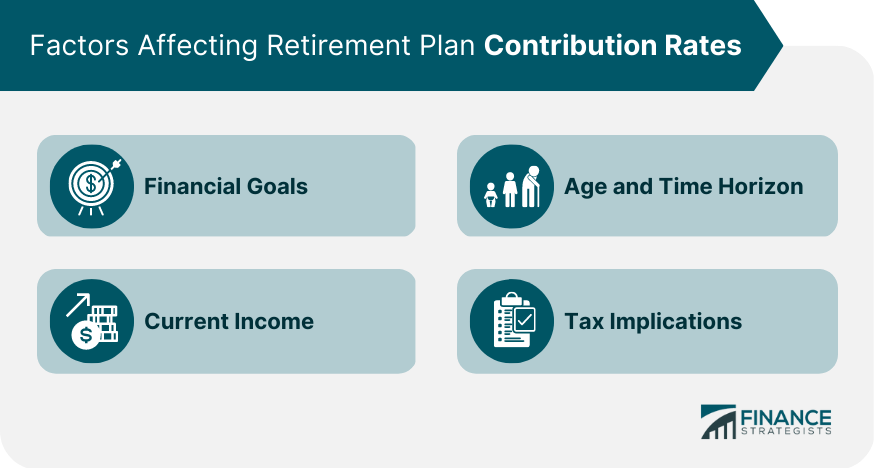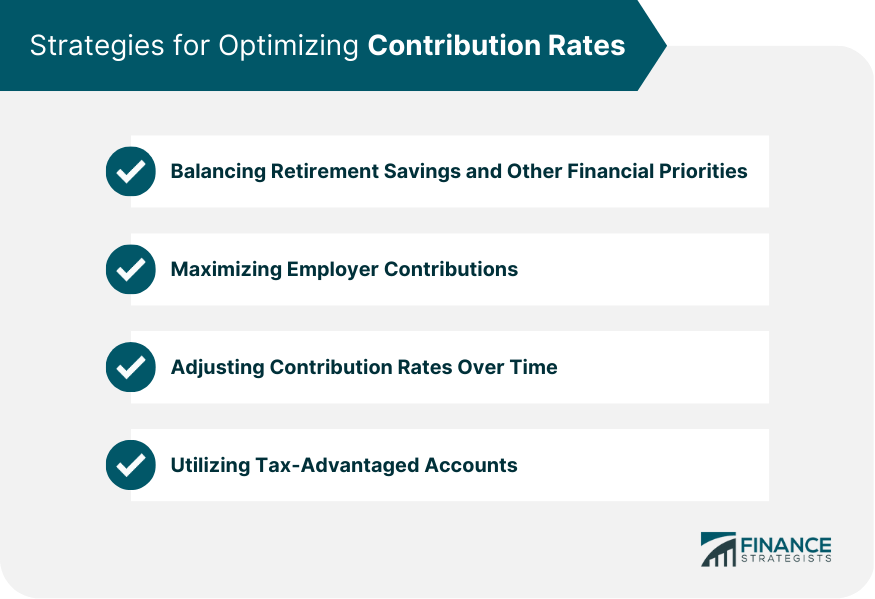A contribution rate refers to the percentage or fixed amount of income that individuals or employers allocate towards various types of accounts or programs, such as retirement plans, pension plans, social security systems, and health and welfare benefit plans. Understanding and managing contribution rates is essential for achieving financial goals, optimizing tax benefits, and securing financial well-being in retirement or other life stages. Employees can choose to contribute a certain percentage or fixed amount of their income to retirement plans, such as 401(k)s, 403(b)s, and IRAs. The contribution rate should align with the individual's financial goals and retirement needs. Some retirement plans feature automatic enrollment and escalation, which set an initial employee contribution rate and gradually increase it over time. This approach can help employees save more for retirement without actively managing their contribution rate. Many employers offer matching contributions to their employees' retirement plans, such as 401(k)s or 403(b)s. The employer's contribution rate typically depends on the employee's contribution rate, up to a specified limit. Non-elective contributions are employer contributions made to an employee's retirement plan, regardless of the employee's own contributions. These contributions can help boost employees' retirement savings. Employers may also contribute to employees' retirement plans through profit-sharing, allocating a portion of company profits to employees' accounts based on a predetermined formula. Individuals should consider their financial goals and retirement needs when determining their contribution rates to retirement plans. Employees should assess their current income and living expenses to decide on an appropriate contribution rate. The age and time horizon until retirement can affect the optimal contribution rate, with younger individuals typically benefiting from higher contribution rates due to the power of compounding over time. Employees should consider the tax implications of their contribution rates, as contributing to tax-advantaged accounts can provide significant tax savings. In defined benefit pension plans, employers are responsible for funding the plan and providing employees with a predetermined retirement benefit. The employer's contribution rate depends on various factors, including plan funding status, actuarial assumptions, and regulatory requirements. In some defined benefit plans, employees are also required to contribute a certain percentage of their income to the plan. The employee's contribution rate may be fixed or variable, depending on the plan's design. Actuarial assumptions, such as interest rates, can affect the required contribution rates for defined benefit pension plans, as lower interest rates generally lead to higher contribution rates. Mortality rates, or the expected lifespan of plan participants, can also impact contribution rates, with longer life expectancies requiring higher contributions to ensure adequate funding. The assumed retirement age for plan participants can affect contribution rates, as later retirement ages may require higher contributions to fund longer periods in retirement. The funding status of a pension plan may require adjustments to contribution rates to ensure the plan remains adequately funded and able to meet its obligations. Social security systems are typically funded through payroll taxes, which are shared between employees and employers. The payroll tax rate determines the contribution rate for both parties, with the total contribution going towards funding social security benefits. Employees and employers are both responsible for contributing a specific percentage of the employee's income to the social security system. The contribution rates may vary depending on the country and the design of the social security system. Self-employed individuals are often required to contribute to social security systems at a different rate than employees and employers. These contributions typically cover both the employee and employer portions of the payroll tax. Employees often contribute to the cost of their health and welfare benefit plans through premium payments. The contribution rate, or the percentage of the premium paid by the employee, can vary depending on the plan design and employer preferences. In addition to premium contributions, employees may also be responsible for cost-sharing, such as deductibles, co-payments, and coinsurance, which represent a portion of the costs incurred for healthcare services. Employers generally contribute to the cost of their employees' health and welfare benefit plans by paying a portion of the premium. The employer's contribution rate can vary depending on factors such as the size of the employer, the competitiveness of the labor market, and the plan design. Some employers offer health reimbursement arrangements (HRAs), which are accounts funded by the employer to help employees pay for qualified medical expenses. The employer's contribution rate to an HRA depends on the terms of the arrangement and the employer's preferences. Individuals should balance their retirement savings contributions with other financial priorities, such as paying down debt, building an emergency fund, and saving for other life goals. Employees should aim to maximize employer contributions to their retirement and benefit plans by contributing enough to meet any applicable matching or profit-sharing thresholds. Individuals should regularly review and adjust their contribution rates based on changes in their financial situation, goals, and time horizon. Taking advantage of tax-advantaged accounts, such as IRAs, 401(k)s, HSAs, and 529 plans, can help individuals optimize their contribution rates and achieve their financial goals more efficiently. Understanding and managing contribution rates is essential for effectively handling personal finances and achieving long-term financial goals. Contribution rates play a vital role in financial planning, as they determine how much individuals can save and invest in various types of accounts and programs. Staying informed about the contribution rates and regularly adjusting one's savings strategy can help optimize tax benefits and ensure compliance with regulatory requirements. To achieve long-term financial success, individuals should strategically allocate contributions across different accounts, such as retirement plans, pension plans, social security systems, and health and welfare benefit plans. By balancing financial priorities, maximizing employer contributions, adjusting contribution rates over time, and utilizing tax-advantaged accounts, individuals can optimize their savings and investments while maximizing tax advantages. Employing these strategies and adhering to contribution limits can pave the way for a more secure financial future.What Is a Contribution Rate?
Contribution Rates in Retirement Plans
Employee Contribution Rates
Voluntary Contributions
Automatic Enrollment and Escalation
Employer Contribution Rates
Matching Contributions
Non-elective Contributions
Profit-Sharing Contributions
Factors Affecting Retirement Plan Contribution Rates
Financial Goals
Current Income
Age and Time Horizon
Tax Implications

Contribution Rates in Pension Plans
Defined Benefit Plans
Employer Contribution Rates
Employee Contribution Rates
Actuarial Assumptions and Funding
Interest Rates
Mortality Rates
Retirement Age
Funding Status and Contribution Rate Adjustments
Contribution Rates in Social Security Systems
Payroll Tax Rates
Employee and Employer Contributions
Self-Employed Contributions
Contribution Rates in Health and Welfare Benefit Plans
Employee Contribution Rates
Premiums
Cost-Sharing
Employer Contribution Rates
Premiums
Health Reimbursement Arrangements (HRAs)
Strategies for Optimizing Contribution Rates
Balancing Retirement Savings and Other Financial Priorities
Maximizing Employer Contributions
Adjusting Contribution Rates Over Time
Utilizing Tax-Advantaged Accounts

Conclusion
Contribution Rate FAQs
A contribution rate is the percentage of an individual's income that they contribute to a particular account or plan, such as a retirement account or savings plan.
The contribution rate is important because it determines how much money an individual is putting towards their long-term financial goals. A higher contribution rate generally leads to a larger balance in the account or plan over time.
A good contribution rate for a retirement account can vary depending on an individual's financial situation and goals. Generally, financial experts recommend contributing at least 10% to 15% of your income to a retirement account.
Yes, you can usually change your contribution rate for most types of accounts or plans. This can be done by adjusting your payroll deductions or making changes to your account settings.
When deciding on your contribution rate, it is important to consider your current income, expenses, and financial goals. You should also take into account any employer matching contributions or other benefits that may be available.
True Tamplin is a published author, public speaker, CEO of UpDigital, and founder of Finance Strategists.
True is a Certified Educator in Personal Finance (CEPF®), author of The Handy Financial Ratios Guide, a member of the Society for Advancing Business Editing and Writing, contributes to his financial education site, Finance Strategists, and has spoken to various financial communities such as the CFA Institute, as well as university students like his Alma mater, Biola University, where he received a bachelor of science in business and data analytics.
To learn more about True, visit his personal website or view his author profiles on Amazon, Nasdaq and Forbes.















